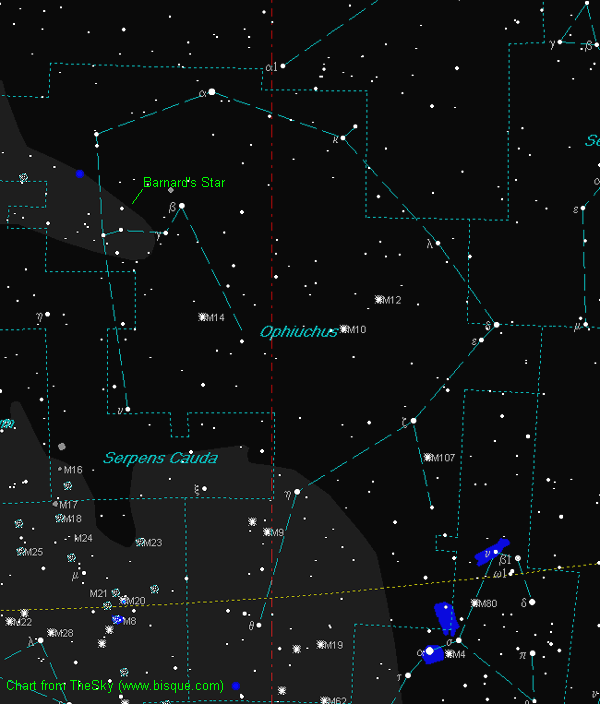Mysterious Ophiuchus
Whenever I host public viewing sessions with my telescope under a dark sky, the subject of horoscopes and astrology always comes up. For some reason most of the general public get astronomy and astrology mixed up. But I play along and ask “what was your sign”? As the person is about to give their answer, facial expressions are priceless as they blurted out, “what do you mean what WAS my sign”. I continue to advise that as of the beginning of 2011 – the zodiac as they knew it has changed and most likely they fall under a different house on the zodiac. In some cases, it seemed like their world came to an end with the change from a Capricorn to a Sagittarius overnight. And as if that was not enough, I add extra insult to injury as I introduce the thirteenth house named Ophiuchus. This change was a long time coming as the specific date should correspond to where the Sun is on your birthday. You can blame Earth’s 26,000-year precession for that.
Many were unaware this had occurred and some were downright shocked. I went on to explain that the astronomical term ecliptic signifies the path of the planets as well as the Sun and Moon as they march across the sky. Astrology refers to this as the Zodiac. The quote-unquote mysterious constellation has always been there, just never used in astrology. This would have meant 13 houses and that was as superstition has it, an unlucky number.

Ophiuchus the Serpent Bearer is located below the constellation Hercules and well place during these warm summer nights. At an impressive area of 948 square degrees, this constellation is ranked eleventh in overall size. Centred in the constellation are three globular clusters. With Ophiuchus being somewhat close to the central bulge of the Milky Way, all we pretty well hunt for are star clusters. From left to right they are labelled as M14, M10 and M12. The first of the trio is M14 and it lies 30,000 light-years away and measures some 11 arc minutes wide. Its magnitude is listed as 7.6. Next, we have M10 which resides half the distance from us or 14,300 light-years. Astronomers have estimated that with a linear size of 20 arc minutes the cluster would be 83 light-years wide on its overall appearance with a 32 light year core. M12 is a tad small at 16 arc minutes. At 16,000 light-years from us, this magnitude 6.7 ball of suns has an impressive 13 variables in it.
NGC 6572, also called the Blue Racquetball is a planetary nebula with a distorted shape. At an estimated distance of 4,900 light-years, we can easily pick up the vivid bluish-green magnitude 12.9 central star in a low power eyepiece. Once you kick the power up to about 100X (depending on your scope) its irregular shape is somewhat resolved. Once these outer wings of gas shed and dissipate, only the colourful star will remain but that will occur a long time from now.
A majority of stars we see in the Milky Way do not appear to move per se, but Barnard’s star does have a notable path through time is currently 6 light-years and has a large proper motion. This star is moving toward us at 140 km/sec and be at its closest of 3.8 light-years somewhere around 8,000 years from now. Even at this speed, Barnard’s star moves the width of the moon in 175 years or 350 years for a full degree of sky.
For a real challenge, might I suggest the dark silhouette of the Snake Nebula or Barnard 72? This object, as well as all Barnard objects (no relation), is a dark lonely cloud, blocking most of all the light from background stars.
Well if the weather holds on the night of the 12th, we should have a great show of annual Perseid meteors. Tiny particles, smaller than the period on this page, will enter our atmosphere and burn up. These small particles hit the atmosphere at 56 km/sec resulting in a fantastic light show that occurs from 80 to 100 km above our heads. There are even occasional fireballs that can and do light up the ground. The 36% lit moon will set at 10:55 p.m. locally thus allowing dark skies to view the 100 meteors per hour. So if the weather forecast predicts clear skies, tell the boss you might be late next morning.
As for the planets, Saturn is still well placed, high in the western sky as the night darkens but sets around 11 pm local time by mid-month. Venus still appears egg-shaped and is marching up the western sky after sunset. As for Jupiter Mars and Mercury, they own the early morning sky and form a tight group in the constellation Gemini.
New Moon is set for August 6 and the full Sturgeon Moon is on the 20th.
Until next month, clear skies everyone.
